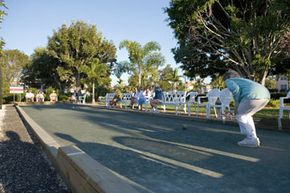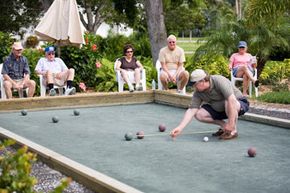Few sports have a 5,000-year history and go really well with a shot of espresso or a glass of Campari. Bocce (pronounced bah-chee) ball is a game of skill and strategy for both serious athletes and amateur enthusiasts. It requires a certain degree of athleticism but is often depicted in film and advertising as a leisure activity for mature Italian men in New York City, Miami and Italy, of course, who roll the game's softball-sized balls while enjoying a drink with friends.
Also spelled boccie or bocci, and sometimes capitalized, bocce ball is an international game that can be played anywhere from a sandy side alley to a clay-soil or dirt park area to a paved court. Egyptians may have been the first to play an early form of bocce ball thousands of years ago, and from there it was likely picked up by the Greeks. They later shared it with the Italians, who formalized the rules and popularized the game. In Australia and the U.S., bocce ball is also considered the Italian form of lawn bowling, though the latter is a separate game usually played on grass with English rules [sources: Buckheit; Encyclopaedia Britannica; NYC Parks].
Advertisement
Although bocce ball is not an Olympic sport -- despite many petitions to have it included -- it has long been an official Special Olympics game. Players are challenged by the physical aspects of the game and gain confidence in using strategy, and the rules are straightforward and basic enough for coaches to communicate to special needs players at all levels. World championships in bocce ball or beach bocce ball also take place internationally.
Aside from special Olympians and those in Italian communities, bocce ball must be popular among many age groups in a range of places because it is considered the sport with the most participants after golf and soccer [source: Special Olympics]. Players in South America, the Balkans and Australia, among others, have their own names for the game of bocce and its balls. In most places it's played, however, people follow the Italian rules.
Advertisement




